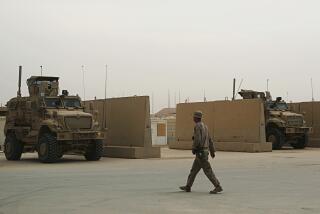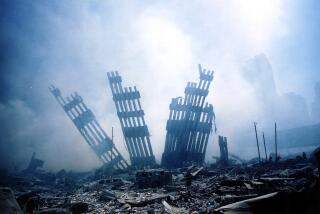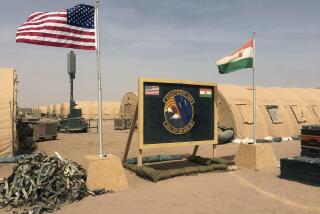U.S. Radically Cutting Military Presence in Saudi Arabia
WASHINGTON — The Pentagon has moved its Middle East air operations control center from Saudi Arabia to neighboring Qatar, and nearly all of the 4,500 service members and 100 planes at Prince Sultan Air Base will leave by August, U.S. military officials said Tuesday.
The decision to mothball the center in Saudi Arabia -- part of the U.S. presence there that has drawn the wrath of terrorists -- was made by “mutual agreement” with the Saudi government, Defense Secretary Donald H. Rumsfeld said after meeting in Riyadh with Saudi Defense Minister Prince Sultan ibn Abdulaziz.
Insisting that the move was not spurred by a deterioration of the U.S. relationship with Saudi Arabia, Rumsfeld said the air base was no longer needed now that the regime of Iraqi President Saddam Hussein had fallen.
“It is now a safer region with the change of regime in Iraq,” Rumsfeld said.
However, the move also eases a major political problem for the Saudis. The presence of American troops in Saudi Arabia, the land of Islam’s two holiest shrines, enraged militant Muslims. It was among the reasons given by Osama bin Laden, the Saudi fugitive who heads the Al Qaeda terrorist network, for his hatred of the United States.
In 1996, 19 U.S. servicemen were killed when Muslim militants bombed the Khobar Towers complex in Dhahran, Saudi Arabia, prompting U.S. military personnel in the country to move to the heavily fortified Prince Sultan Air Base deep in the Saudi desert.
“It’s a problem to be there,” said Michael Vickers, a military analyst at the Center for Strategic and Budgetary Assessments. “It’s a grievance for the radical Islamists, and there are lots of other bases that are available.”
Military personnel began moving out of the air operations center and into Qatar more than a week ago.
The decision to move most troops out of Saudi Arabia, where the military has maintained an important presence since the time of the 1991 Persian Gulf War, is part of a realignment of U.S. forces in and around Iraq.
The center was established after the 1991 war and was used to direct U.S.-led airstrikes on Iraq in the most recent conflict. It was also the center of air control operations for the U.S. military campaign in Afghanistan.
Saudi unease about the presence of U.S. troops in the country was manifest in attempts by the government to stifle news that American commanders were running the latest Iraq air war from Prince Sultan.
But Saudi authorities, while publicly decrying the U.S. military presence, have quietly invested hundreds of millions of dollars in improving the base for U.S. troops, building a housing complex, a gymnasium and recreation and health centers. They have also paid to help feed and supply U.S. troops at the base and at more than half a dozen other military facilities to help counter the Iraqi threat.
At the height of the recent Iraq war, about 200 allied aircraft were based at Prince Sultan. Officials said many types of planes flew from there, including F-16CJs, F-15Cs and Airborne Warning and Control System aircraft.
The Pentagon is likely to maintain access to the base and use it with some frequency for military exercises, and it probably will keep equipment there and elsewhere in Saudi Arabia, defense officials said.
It is unclear whether a small cadre of Americans will remain beyond August to keep the base ready in case of emergency, officials said.
The drawdown of forces in Saudi Arabia is part of a broader Pentagon plan to scale back its presence across the Middle East.
This month, the Pentagon removed 30 of the 80 fighter jets and almost half the 4,500 U.S. personnel from Incirlik Air Base in Turkey. Within months, it also plans to move most of its aircraft and troops out of Oman.
More to Read
Sign up for Essential California
The most important California stories and recommendations in your inbox every morning.
You may occasionally receive promotional content from the Los Angeles Times.










